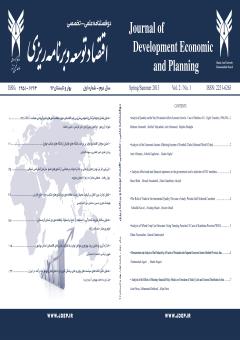تحلیل عوامل موثر بر تمایل به پرداخت در مشاغل غیر رسمی اصفهان با استفاده از روش توبیت
محورهای موضوعی : دو فصلنامه علمی - تخصصی اقتصاد توسعه و برنامه ریزیمنصور عسگری 1 , مصطفی رجبی 2 * , شهرام توفیقی 3 , مریم شریف دوست 4
1 - دانشجوی دکتری اقتصاد سلامت، گروه علوم اقتصادی، واحد خمینی شهر، دانشگاه آزاد اسلامی، خمینی شهر، ایران.
2 - استادیار گروه اقتصاد، دانشگاه آزاد اسلامی، واحد خمینی شهر، اصفهان، ایران
3 - مرکز تحقیقات مدیریت سلامت، دانشگاه علوم پزشکی بقیه ا… (عج)، تهران ،ایران
4 - هیات علمی
کلید واژه: : بیمه سلامت, مشاغل غیررسمی, تمایل به پرداخت, اقتصاد سلامت, روش ارزشگذاری مشروط, مدل توبیت, مدل پروبیت رتبهای,
چکیده مقاله :
هدف این مطالعه، ارزیابی تمایل به پرداخت برای ارتقاء پوشش بیمه درمانی در میان شاغلان مشاغل غیررسمی در شهر اصفهان است. با استفاده از روش ارزشگذاری مشروط و مدل توبیت ، . با استفاده از فرمول کرجسی-مورگان، و در نظر گرفتن حجم جامعه هدف، حجم نمونه نهایی برابر389 پاسخگوی فاقد بیمه تأمین اجتماعی و تحت پوشش بیمه سلامت همگانی تحلیل شد.یکی از روشهای پرکاربرد برای اندازهگیری WTP، روش ارزشگذاری مشروط است. در این روش، از پاسخدهندگان خواسته میشود در یک سناریوی فرضی، مقدار پولی را که حاضرند برای دریافت یک خدمت خاص بپردازند، اعلام کنند.پس از طراحی پرسشنامه جهت اعتبار سنجی ان پایایی و روایی را به ترتیب ازروش ازمون باز ازمون و شاخص باسل استفاده شد.پرسشنامه از روش دوگانه دو بعدی تکمیل و در انتها نیز از ی سوال انتهای باز استفاده شد.برای تجزیه و تحلیل دادهها از نرمافزار Stata17 برای تخمین مدل توبیت و از SPSS برای آمار توصیفی و اعتبارسنجی پرسشنامه استفاده شد.
نتایج نشان داد که درصد قابل توجهی از افراد حاضرند مبلغی بیش از سطح یارانهای فعلی برای بهرهمندی از خدمات گستردهتر، از جمله دسترسی اسانتر به مراکز درمانی خصوصی و حذف الزام نظام ارجاع، پرداخت کنند. متغیرهایی مانند درآمد، سن، هزینههای سلامت و بعد خانوار اثر معناداری بر تمایل به پرداخت داشتند. یافتهها بر ضرورت طراحی بستههای بیمهای انعطافپذیر و مشارکتی برای گروههای شاغل غیررسمی تأکید دارند.
The aim of this study is to assess the willingness to pay for the promotion of health insurance coverage among informal workers in Isfahan. Using the conditional valuation method and the Tobit model, . Using the Krejci-Morgan formula, and considering the size of the target population, the final sample size was analyzed as 389 respondents without social security insurance and covered by public health insurance. One of the most widely used methods for measuring WTP is the conditional valuation method. In this method, respondents are asked to state the amount of money they are willing to pay to receive a specific service in a hypothetical scenario. After designing the questionnaire, the reliability and validity were validated using the open-ended test and Basel index methods, respectively. The questionnaire was completed using the two-dimensional dual method and at the end, an open-ended question was used. Stata17 software was used to estimate the Tobit model and SPSS was used for descriptive statistics and validation of the questionnaire.
The results showed that a significant percentage of individuals were willing to pay more than the current subsidy level to benefit from broader services, including easier access to private health centers and the elimination of the referral system requirement. Variables such as income, age, health expenditures, and household size had a significant effect on willingness to pay. The findings emphasize the need to design flexible and participatory insurance packages for informally employed groups.

